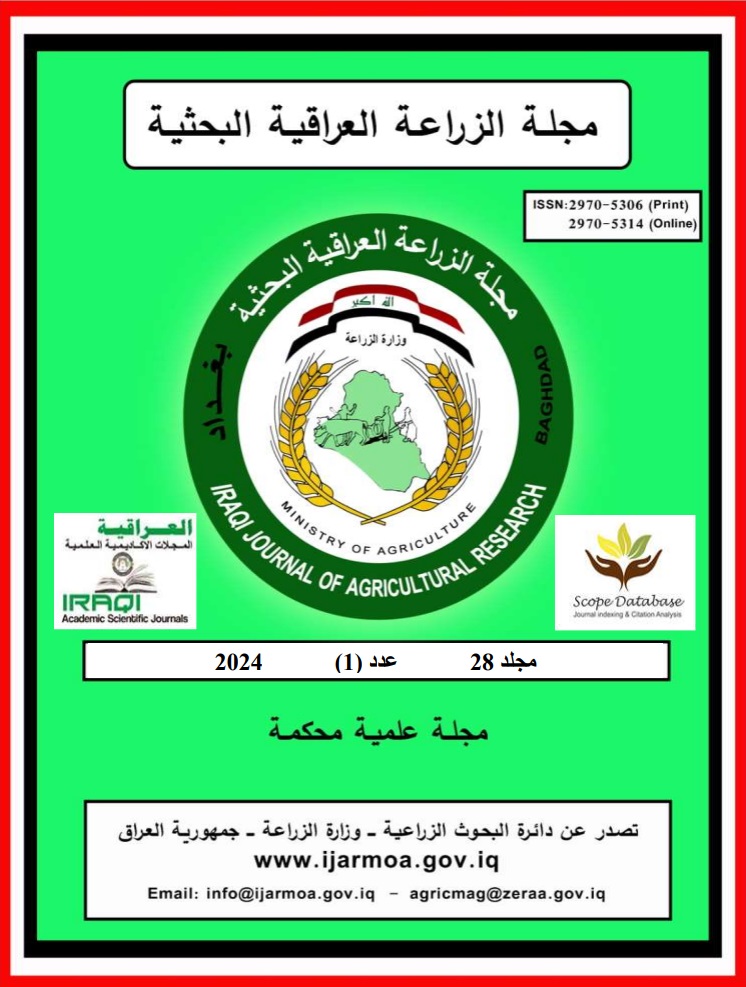Abstract
At the Nasr Dairy Cattle Station, (50 km south of Baghdad) and over period from 1998 to 2003, 9896 records by Holstein cows were analyzed statistically. The study was conducted to some factors effected on incidence of retained placenta . fifty Holstein cows were randomly picked out from the herd (from May to September month, 2004). The aim of this study was to investigate the blood and reproductive changes associated with incidence of retained placenta The General Linear Model (GLM) with in the SAS program was used to study the effects of parity, season and year of parturition and birth weight on incidence of retained placenta in herd, and analysis the effect of constant (healthy or infected) and fixed factors (parity), season of parturition and age at first calving in some reproductive and productive traits days open, services per conception, total milk production and lactation period and blood traits (level of Calcium and Magnesium in blood serum).Results obtained can be summarized as follows: The overall mean for the incidence of the retained placenta in herd was 6%. Highly significant effects (P<0.01) of fixed factors incidence of retained placenta, the highest incidence of cows after the sixth parturition (12%) in summer (8.9%). Cow state had highly significant (P<0.01) effect on days open, services per conception and total milk production and significant effect (P<0.05) in lactation period. Parity had significant effect (P<0.05) effect on days open and total milk production, whereas, its effect on services per conception lacked significant. Parturition month had significant (P<0.05) on days open and services per conception. Regression coefficient of days open, services per conception, total milk production and lactation period on the age at first calving 0.24 day / month (P<0.01), 0.0045 services / month, - 0.22 kg / month and 0.33 day / month (P<0.05) respectively. Significant decreased (P<0.01) in level of Calcium and Magnesium in blood serum at incidence of retained placenta. Parity had significant (P<0.05) in level of Magnesium in blood serum, whereas, its effect on level of Calcium lacked significant. Regression coefficient of level of Calcium and Magnesium in blood serum on age at first calving were 0.0029 mg /100 ml blood/ month (P<0.01) and 0.0009 mg /100 ml blood / month respectively.
Abstract
شملت الدراسة تحليل 9896 قيدا من سجلات عائدة لابقار الهولشتاين للمدة من 1998 ولغاية عام 2003 في محطة النصر التابعة للشركة المتحدة للثروة الحيوانية المحدودة في الصويرة لدراسة التغيرات الدموية والفسلجية المرافقة للاصابة باحتباس المشيمة من خلال تأثير حالة البقرة (سليمة او مصابة بالاحتباس) وبعض العوامل الثابتة (تسلسل الدورة الانتاجية وشهر الولادة والعمر عند الولادة الاولى) في مستوى الكالسيوم والمغنيسيوم في مصل الدم. بلغ المعدل العام لنسبة الاصابة باحتباس المشيمة في القطيع 6%. وكان هنالك تأثير عالي المعنوية للعوامل الثابتة المدروسة في نسبة الاصابة باحتباس المشيمة، ولوحظ أن اقصى نسبة اصابة سجلت لدى الابقار بعد الولادة السادسة (12%) والوالدة صيفاً (8.9%). اظهرت نتائج الدراسة ان هنالك انخفاضاً معنوياً (P<0.01) في مستوى الكالسيوم والمغنيسيوم في مصل الدم عند الاصابة باحتباس المشيمة. ان لتسلسل الدورة الانتاجية تاثيراً معنوياً (P<0.05) في مستوى مغنيسيوم مصل الدم في حين لم يتأثر مستوى الكالسيوم بهذا العامل. بلغ معامل انحدارمستوى الكالسيوم والمغنيسيوم في مصل الدم على العمر عند الولادة الاولى 0.0029 ملغم /شهر(0.01>p) < 0.05) على التوالي.
